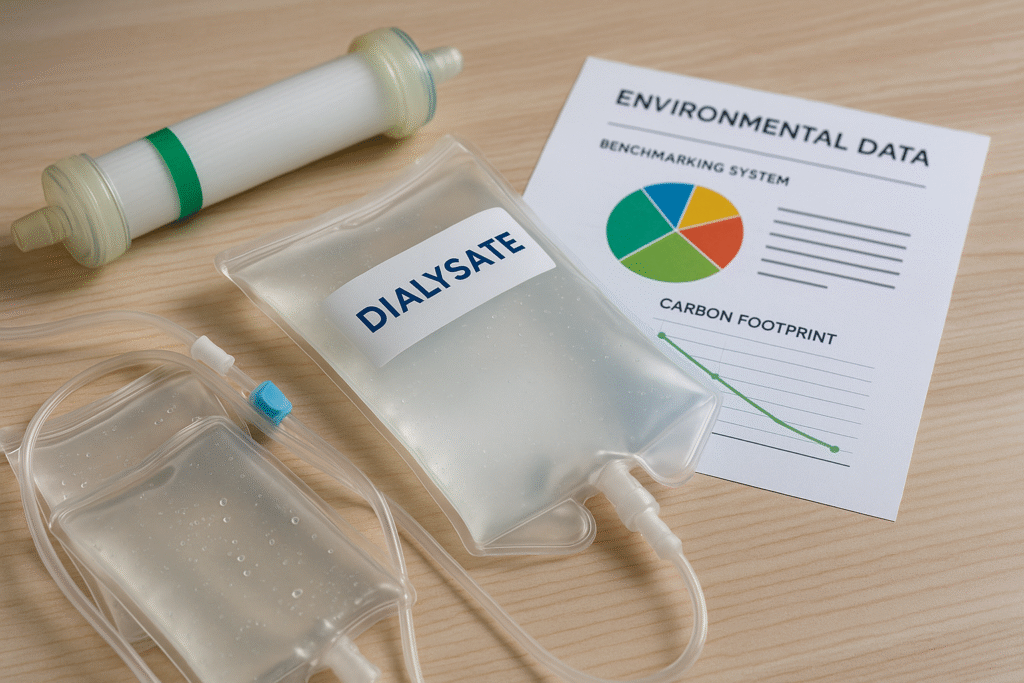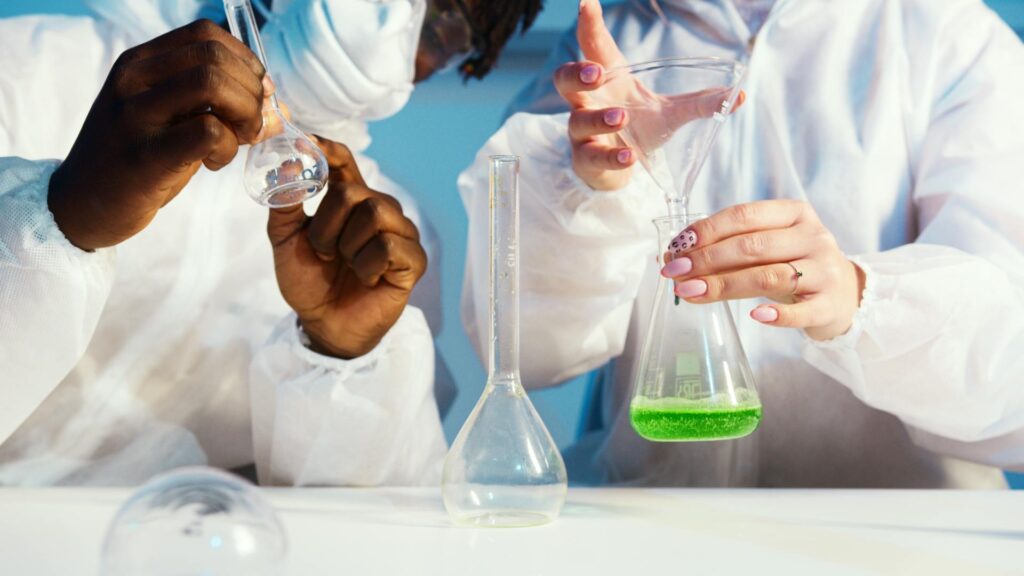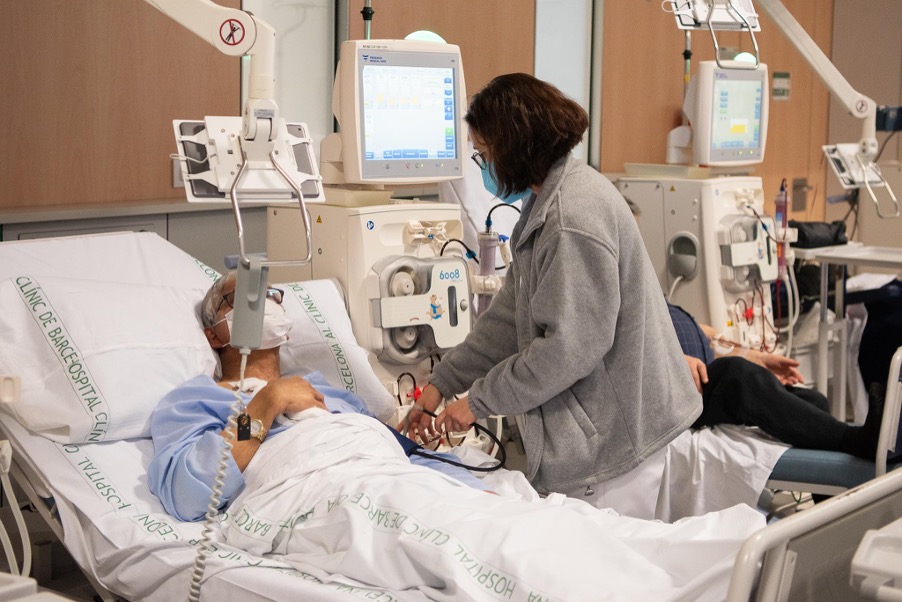
James Larkin’s journey in greener kidney care: innovations shaping the future of kidney care (Part 2)

In this second article of our two-part series, we continue to follow James Larkin’s journey in the KitNewCare project, highlighting innovations aimed at reshaping kidney care. Building upon the sustainability insights explored in Part 1, readers will discover exciting solutions such as locally generated dialysate systems, advanced waste management practices, and emerging tools like AI and benchmarking systems poised to transform hospital practices. Larkin’s collaborative spirit and future-focused vision underline how creativity and commitment can drive meaningful change in healthcare sustainability.
Local solutions: dialysate on tap
One of Larkin’s standout projects in the past year was a comparative analysis of dialysate supply methods. Dialysate, the fluid used in dialysis to draw out toxins from blood, is typically delivered to clinics in heavy canisters or bags, requiring frequent truck deliveries and generating piles of plastic waste. However, a KitNewcare project partner team in Modena, Italy, introduced Larkin to an alternative: a machine that can produce dialysate concentrate on site from powder and water. (This technology, known as a central acid delivery system or by the brand name Granumix, allows clinics to mix dialysate locally in bulk). Larkin immediately recognised the sustainability potential. “Most hospitals use canisters that they get shipped in,” he explains. “So we decided it would be a good idea to run a life cycle assessment and compare the two.”
The results were striking. “That [local dialysate mixing] system has been a game changer in terms of environmental impact and carbon emissions,” Larkin reports. The machine significantly reduces the need to transport large volumes of fluid, since only concentrated powder is delivered, and it slashes the amount of single-use plastic packaging. In a recent nephrology study, switching a 30-bed dialysis unit from 5-liter acid concentrate jugs to a bulk central system cut carbon emissions by roughly 33,500 kg CO₂e per year, mostly by eliminating plastic waste and delivery trips. Larkin’s analysis of the Modena machine echoed these benefits. “They’re not having to transport nearly as much product to the hospital,”he says, which means fewer delivery trucks on the road and less storage space needed.
Perhaps just as rewarding for Larkin was seeing the immediate interest from clinicians when he shared this research. “When we were in Madrid presenting, one of the doctors came up afterward and said, ‘I’ve never heard of that machine before. It’s such a good idea,’” Larkin recalls. “She told me they just use canisters delivered in, and that’s something she’d definitely be looking into now.” For a researcher early in his career, this kind of real-world impact is highly motivating: it shows that data and evidence can drive change on the ground. Larkin’s collaboration with the Italian team not only produced a publication but is already influencing practice by spreading knowledge of innovations like the Granumix system to places that hadn’t considered it.
Turning waste into resource: the promise of pyrolysis
Waste management is another area in kidney care ripe for innovation. Dialysis treatments generate a lot of waste, from plastic tubing and bags to used dialysers and contaminated packaging. In many cases, especially for home dialysis, patients simply dispose of used supplies in the general trash, which then goes to incineration or landfill. “Healthcare waste is quite high in these treatments,” Larkin notes. “Most healthcare products are just incinerated after they’re used, especially when treatment is done at home, patients just throw them into the general bin.” Incinerating medical waste, while necessary for infection control, produces CO₂ emissions and other pollutants. It also squanders the materials (like plastics) that could be potentially recycled or recovered.
Larkin and his PhD supervisor Dr Brett Duane, Principal Investigator of the KitNewCare project, decided to explore an advanced recycling approach known as pyrolysis. Pyrolysis involves heating shredded plastic waste at high temperatures in the absence of oxygen, breaking it down into smaller molecular components. “We’re looking at a new waste management process called pyrolysis,” Larkin explains excitedly. “From the shredding and processing of the products, it turns it back into ethylene, basically plastic, which you can reuse again. And the carbon footprint of that is significantly less than current practices.” In other words, instead of burning dialysis waste and treating it as garbage, pyrolysis could allow much of the plastic to be reclaimed as raw material to make new products. Early studies show that chemical recycling via pyrolysis can have roughly 50% lower greenhouse gas impact than incineration, though it requires well-sorted waste streams and advanced facilities.
For Larkin, pyrolysis is a perfect example of thinking outside the box, or in this case, outside the waste bin. Implementing it in healthcare will not be simple; it demands coordination (collecting and sorting used supplies), technology investment, and regulatory approvals. But if successful, it could dramatically shrink the footprint of dialysis by closing the loop on plastic. James and Dr Duane are currently writing a paper on waste and kidney care, highlighting pyrolysis as a promising solution. By publishing data on how much carbon could be saved, they aim to make the case that hospitals and policymakers should pilot these new waste-processing methods. The ultimate vision is a future where dialysis has a “circular” lifecycle: the end products of today’s treatments become the raw materials for tomorrow’s supplies.
Collaboration: a Europe-wide effort
Working on KitNewCare has also shown Larkin the power of collaboration in driving sustainable innovation. The project spans multiple countries and disciplines, bringing together engineers, clinicians, sustainability experts, and patient representatives. “We’ve been working with a lot of different people. It’s great,” Larkin says. For example, his comparative dialysate study was done with a team at the University of Modena in Italy, who provided real-world data on their in-house mixing system. He’s also teamed up with researchers from the Centre for Sustainable Healthcare in the UK, a leading organisation in green healthcare, on a comprehensive review of interventions to make kidney care more sustainable. “We’re looking at different ideas and solutions to make kidney care more sustainable,” Larkin notes, describing a scoping review that combs through publications and projects worldwide. This effort will catalogue everything from energy-saving technologies and water conservation measures to novel care models like telemedicine or home therapies that cut travel.
Sustainability in healthcare is not only about technology; it’s also about people and policies. To understand the barriers and facilitators to greener kidney care, Larkin is preparing to conduct 25 qualitative interviews with experts in the field. These experts include nephrologists, nurses, hospital administrators, and sustainability officers who have experience (or interest) in reducing healthcare’s environmental impact. “We want to see how people think sustainability is going in kidney care, and what they would like to see happen,” Larkin explains. He’s particularly interested in the on-the-ground realities, what stops a hospital from adopting a new eco-friendly machine, or what motivates a clinic to invest in solar panels or reusable dialysers. By gathering these insights, Larkin hopes to identify practical strategies to overcome obstacles. The interviews are set to begin as soon as ethical approvals are in place, and he anticipates that the findings will enrich the project’s recommendations with real-world context.
Throughout this journey, Larkin has been mentored by and worked alongside seasoned professionals. He mentions a systematic review on patient and staff experiences in end-stage kidney disease that he’s doing with Dr Bridget Johnston and a Randolf Anokye, to ensure that patient-centred outcomes remain in focus. And within the KitNewCare consortium, he regularly collaborates with his supervisor Dr Brett Duane and fellow PhD candidates like Abbas Fehintola and Rodrigo Martínez Cadenas, each contributing their expertise: from innovative dialyser design (as Abbas presented on a new “ClearFlux” dialyser with a lower environmental impact) to artificial intelligence programming (as Rodrigo applies AI to sustainability data). Larkin credits this team science approach for the project’s progress. It hasn’t always been easy (“keeping it all in sync” can be challenging, he notes), but the exchange of ideas across countries and disciplines is yielding results that no single researcher or hospital could achieve alone.
Looking ahead: tools and hopes for greener kidney care
As James Larkin looks to the future, he is optimistic about the lasting impact of KitNewCare. One concrete outcome will be practical tools for hospitals and decision-makers. “I’d hope that some of the data we’ve gathered would be used to help design the way hospitals run their clinics, from a sustainability point of view,” Larkin says. To that end, the project is developing a benchmarking system that clinics can use to measure their environmental performance. In collaboration with the Centre for Sustainable Healthcare, Larkin’s data on dialysis emissions, water usage, and waste will feed into this benchmarking tool. It will likely take the form of a user-friendly spreadsheet or software where a renal unit can input their resource use and see how they stack up against best practices or national averages. The idea is to highlight where they can improve. For example, if one centre’s water use per dialysis session is twice as high as another’s, that flags an opportunity to investigate and optimise. “That benchmarking tool… It’s using our data and it will hopefully make a big impact,” Larkin notes, envisioning it as a catalyst for competition and improvement among hospitals.
Another innovative deliverable is an AI-powered support agent for sustainable healthcare. Larkin’s colleague Rodrigo, with assistance from others on the team, is creating an AI system trained on all the data and findings from KitNewCare. “It’s an AI… you can ask it a question about something in the hospital or in kidney care, and it’ll give you a really good answer using all our data,” Larkin explains. Think of it as a smart assistant for a clinic manager or renal technician: one could ask, “What can I do to reduce carbon emissions from our dialysis unit’s water system?” and the AI, drawing from the latest research and benchmark data, would respond with tailored suggestions (for instance, recycling reverse osmosis reject water, or installing solar heaters for the water system, etc.). “You could ask, like, ‘What could I do to improve the carbon emissions for a blood examination?’ and it would give an answer based on what we’ve done,” Larkin says, giving another example. He’s clearly excited about this high-tech approach: the AI can serve as a quick-reference guide, educator, and brainstorming partner all in one, accessible to busy healthcare professionals who might not have time to pore over lengthy reports.
Larkin’s product design mindset makes him particularly enthusiastic about these tangible outputs. “Those are two really powerful ones,” he says of the benchmarking tool and AI agent. “I have a product design background, so I think of what products or interventions can make a difference.” In addition to these, he hints at other innovations on the horizon. For instance, more portable dialysis devices that could allow treatments like hemodialysis to be done at home or on the move with a smaller machine. Larkin is advising one company on assessing the sustainability of a new portable artificial kidney prototype. Such devices could potentially reduce infrastructure needs and make dialysis not just greener but more flexible for patients. While details are under wraps, it’s an example of how industry and academia are starting to align on the goal of eco-design in healthcare technology.
Above all, James hopes that his research will inspire and empower the kidney care community to act. Publishing papers and giving conference talks is important, but the true success will be measured in changes on the ground. “The papers we’re working on now will feed into these tools, which will hopefully make a big impact,” he says. Even simple awareness can go a long way, as many clinicians are still unaware of the environmental toll of kidney care and the available solutions. Larkin’s outreach is changing that. As he recounts, after one presentation, a nephrologist told him she’d never considered some of these interventions before, but now she was eager to implement them. These moments convince Larkin that attitudes are shifting. There is a growing recognition that sustainability should be a part of quality care.
James’s journey from a novice outsider to a driving force in sustainable kidney care illustrates the power of fresh perspectives in healthcare innovation. In just over a year, he has gone from learning the ABCs of dialysis to co-authoring studies and shaping new tools that could redefine how dialysis units operate. His work under the KitNewCare project is more than an academic exercise, it’s a passionate quest to ensure that life-saving treatments like dialysis do not inadvertently harm the planet that sustains us.
For healthcare professionals, Larkin’s story is a reminder that improving patient care and reducing environmental impact can go hand in hand. Whether it’s rethinking how we deliver dialysate, choosing machines that consume less, encouraging home therapies and incremental starts, or finding value in “waste” through pyrolysis, the opportunities for greener practice are abundant. For patients and the public, it offers hope that the future of healthcare can be both high-tech and eco-conscious, maintaining human health while caring for our environment.
Standing at the nexus of engineering, medicine, and environmental science, James Larkin embodies a new generation of researcher. One that treats sustainability as integral to healthcare excellence. “We have to show there is another way,” he says, reflecting on the mission that keeps him motivated. As KitNewCare progresses, the lessons from Larkin’s research are poised to spread across Europe and beyond. They carry a lasting message: with creativity, collaboration, and commitment, even a resource-intensive field like kidney care can transform itself for a healthier planet and healthier people in the years to come.

Save the date: Innovation Challenge 2 to accelerate sustainable kidney care across Europe

Green kidneys: solving nephrology’s climate paradox

